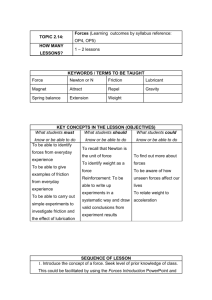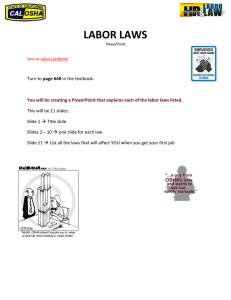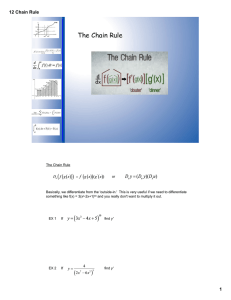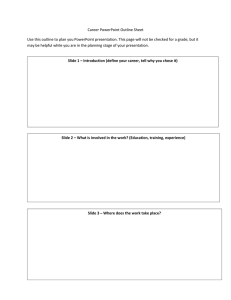TOPIC 2.15: Pressure (Learning outcomes by syllabus reference
advertisement
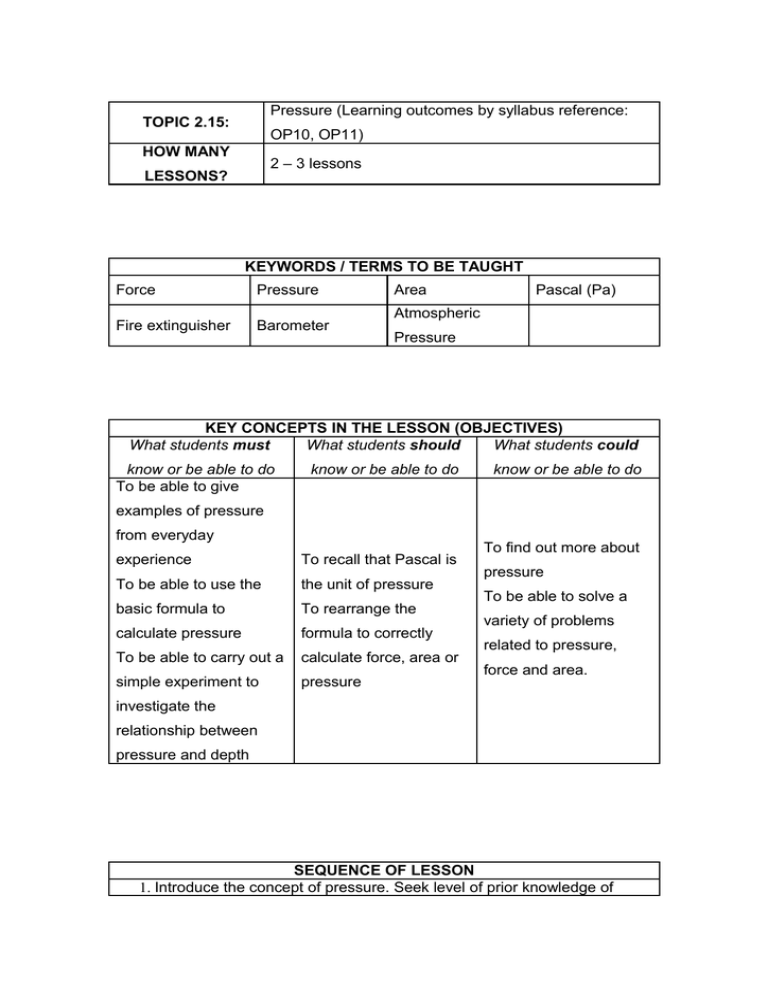
Pressure (Learning outcomes by syllabus reference: TOPIC 2.15: OP10, OP11) HOW MANY 2 – 3 lessons LESSONS? KEYWORDS / TERMS TO BE TAUGHT Force Pressure Fire extinguisher Barometer Area Pascal (Pa) Atmospheric Pressure KEY CONCEPTS IN THE LESSON (OBJECTIVES) What students must What students should What students could know or be able to do To be able to give know or be able to do know or be able to do examples of pressure from everyday experience To recall that Pascal is To be able to use the the unit of pressure basic formula to To rearrange the calculate pressure formula to correctly To be able to carry out a calculate force, area or simple experiment to pressure To find out more about pressure To be able to solve a variety of problems related to pressure, force and area. investigate the relationship between pressure and depth SEQUENCE OF LESSON 1. Introduce the concept of pressure. Seek level of prior knowledge of class. Allow students to relate personal experiences of pressure, e.g. tyre pressure. This could be facilitated by using the Pressure Introduction PowerPoint and encouraging student input during the presentation. 2. Carry out basic sums to calculate pressure. Carry out a simple experiment (using plastic bottles) in groups to show the effects of depth in liquids on pressure. Discussion of key vocabulary, results and conclusions. 3. Review – whole class discussion/dissemination of ideas/extra information. Possibility of using Pressure Quiz PowerPoint to facilitate student understanding. 4. Further class work/homework – see Pressure Worksheet. Devise extension activities as required. 1. DIFFERENTIATE BY CONTENT (In what ways can I vary the content of what I am teaching?) (A) Complexity of content: (concrete, symbolic, abstract) Concrete Real materials associated with pressure, e.g. thumb tacks, football boot, high-heeled shoe, flat shoe etc. Symbolic Units: Pascal (Pa) Abstract Rearranging the formula Newspaper articles/ to calculate force or personal experiences area. relating to pressure, Appreciation of the images of dams, significance of pressure scuba divers, in our daily lives, e.g. fire submarines extinguishers (B) Variety of resources As listed above. Also potential use of the Internet and/or school library. (C) Variety of learning environments Classroom, school laboratory, computer room/library (as indicated above) 2. DIFFERENTIATE BY PROCESS (How will I teach the lesson?) Sequence of lesson as laid out above Introduction – using concrete or symbolic material or a general class discussion Divide class into groups to carry out simple calculations. Divide class into groups to carry out the experiment. Students may take notes or draw diagrams of any observations made. For resources, guidance and support related to facilitating student experiments and investigations, see www.juniorscience.ie Possible use of Pressure Quiz PowerPoint to facilitate discussion. 3. DIFFERENTIATE BY OUTCOME / PRODUCT (How will the student demonstrate understanding?) See Worksheets, Classroom Activities and Experiments sections of this resource pack. • Students may use a template from the Experiments section to assist them with the write-up of their observations. • Students could be given the opportunity to record their observations on tape. • Students could create a poster showing images of pressure with some basic calculations, e.g. high-heeled shoe etc. • Some students may come up with different ideas for measuring pressure in liquids. • Whole class review work completed at end of class • Homework: Pressure Worksheet if not used for class work. Specify time to be allocated to this work at home. • FINALLY - ANY OTHER POSSIBILITIES FOR THIS LESSON? DVD/Video of pressure in action, e.g. volcano erupting, a dam bursting • Other written activities, e.g. an extended piece of writing entitled ‘Everyday uses of pressure’ • Cross-curricular links: Geography • Internet search for material on pressure • Suggested Internet links include www.juniorscience.ie, www.bbc.co.uk/schools, www.scoilnet.ie, www.skoool.ie and http://classroom.jc-schools.net/sci-units/force.htm • For advice on enhancing curricular access through the use of mobile ICT, see www.laptopsinitiative.ie
